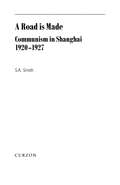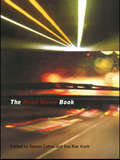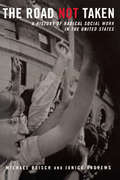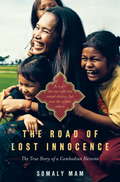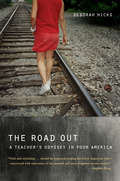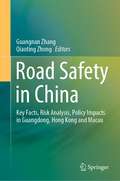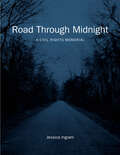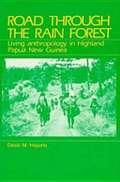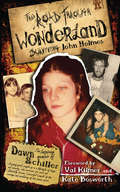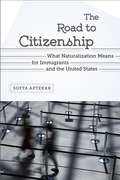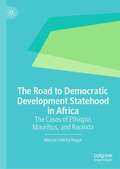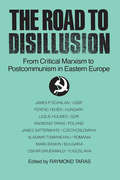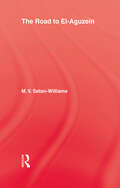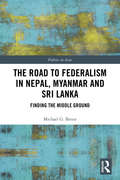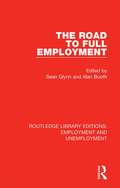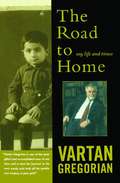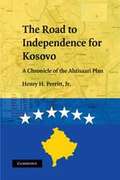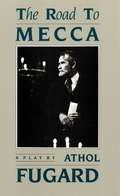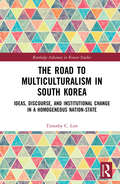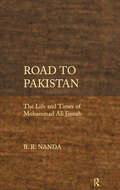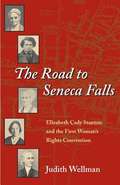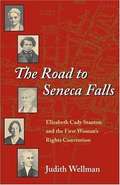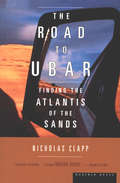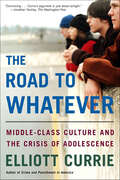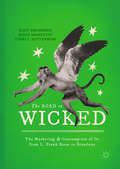- Table View
- List View
A Road Is Made: Communism in Shanghai 1920-1927 (Chinese Worlds)
by Steve SmithThis is a study of the activities, ideas and internal life of the Chinese Communist Party in Shanghai during its formative period. It investigates the party's relations to the city's students and teachers, women, entrepreneurs, secret societies and its workers, and examines the efforts to transform the CCP into a 'Leninist' party, exploring relations between intellectuals and workers, men and women, Chinese and Russians within the party. The book culminates in a detailed analysis of the three armed uprisings which led to the CCP's briefly taking power in March 1927, before being crushed by troops loyal to Chiang Kai-shek. The study highlights the extent to which the Soviet Union sought to manipulate China's national revolution, yet also reveals how divisions at every level of the Comintern allowed the CCP to achieve a degree of independence and to conduct policy at considerable variance with that laid down by Moscow.
The Road Movie Book
by Steven Cohan Ina Rae HarkThe Road Movie Book is the first comprehensive study of an enduring but ever-changing Hollywood genre, its place in American culture, and its legacy to world cinema. The road and the cinema both flourished in the twentieth century, as technological advances brought motion pictures to a mass audience and the mass produced automobile opened up the road to the ordinary American. When Jean Baudrillard equated modern American culture with 'space, speed, cinema, technology' he could just as easily have added that the road movie is its supreme emblem.The contributors explore how the road movie has confronted and represented issues of nationhood, sexuality, gender, class and race. They map the generic terrain of the road movie, trace its evolution on American television as well as on the big screen from the 1930s through the 1980s, and, finally, consider road movies that go off the road, departing from the US landscape or travelling on the margins of contemporary American culture.Movies discussed include:* Road classics such as It Happened One Night, The Grapes of Wrath, The Wizard of Oz and the Bob Hope-Bing Crosby Road to films* 1960's reworkings of the road movie in Easy Rider and Bonnie and Clyde* Russ Meyer's road movies: from Motorpsycho! to Faster Pussycat! Kill! Kill!* Contemporary hits such as Paris Texas, Rain Man, Natural Born Killers and Thelma and Louise* The road movie, Australian style, from Mad Max to the Adventures of Priscilla, Queen of the Desert.
The Road Not Taken: A History of Radical Social Work in the United States
by Michael Reisch Janice AndrewsThe Road Not Taken takes a new perspective on the course of social welfare policy in the twentieth century. This examination looks at the evolution of social work in the United States as a dynamic process not just driven by mainstream organizations and politics, but strongly influenced by the ideas and experiences of radical individuals and marginalized groups as well.
The Road of Lost Innocence: As a girl she was sold into sexual slavery, but now she rescues others. The story of a Cambodian heroine.
by Somaly MamA portion of the proceeds of this book will be donated to the Somaly Mam Foundation.A riveting, raw, and beautiful memoir of tragedy and hopeBorn in a village deep in the Cambodian forest, Somaly Mam was sold into sexual slavery by her grandfather when she was twelve years old. For the next decade she was shuttled through the brothels that make up the sprawling sex trade of Southeast Asia. Trapped in this dangerous and desperate world, she suffered the brutality and horrors of human trafficking--rape, torture, deprivation--until she managed to escape with the help of a French aid worker. Emboldened by her newfound freedom, education, and security, Somaly blossomed but remained haunted by the girls in the brothels she left behind.Written in exquisite, spare, unflinching prose, The Road of Lost Innocence recounts the experiences of her early life and tells the story of her awakening as an activist and her harrowing and brave fight against the powerful and corrupt forces that steal the lives of these girls. She has orchestrated raids on brothels and rescued sex workers, some as young as five and six; she has built shelters, started schools, and founded an organization that has so far saved more than four thousand women and children in Cambodia, Thailand, Vietnam, and Laos. Her memoir will leave you awestruck by her tenacity and courage and will renew your faith in the power of an individual to bring about change.To learn more about how you can help fight human trafficking, visit the foundation's website: www.somaly.org.
The Road Out
by Deborah HicksCan one teacher truly make a difference in her students' lives when everything is working against them? Can a love for literature and learning save the most vulnerable of youth from a life of poverty? The Road Out is a gripping account of one teacher's journey of hope and discovery with her students--girls growing up poor in a neighborhood that was once home to white Appalachian workers, and is now a ghetto. Deborah Hicks, set out to give one group of girls something she never had: a first-rate education, and a chance to live their dreams. A contemporary tragedy is brought to life as she leads us deep into the worlds of Adriana, Blair, Mariah, Elizabeth, Shannon, Jessica, and Alicia?seven girls coming of age in poverty. This is a moving story about girls who have lost their childhoods, but who face the street's torments with courage and resiliency. "I want out," says 10-year-old Blair, a tiny but tough girl who is extremely poor and yet deeply imaginative and precocious. Hicks tries to convey to her students a sense of the power of fiction and of sisterhood to get them through the toughest years of adolescence. But by the time they're sixteen, eight years after the start of the class, the girls are experiencing the collision of their youthful dreams with the pitfalls of growing up in chaotic single-parent families amid the deteriorating cityscape. Yet even as they face disappointments and sometimes despair, these girls cling to their desire for a better future. The author's own life story--from a poorly educated girl in a small mountain town to a Harvard-educated writer, teacher, and social advocate--infuses this chronicle with a message of hope.
Road Safety in China: Key Facts, Risk Analysis, Policy Impacts in Guangdong, Hong Kong and Macau
by Guangnan Zhang Qiaoting ZhongThis book presents comprehensive research and analyses on road traffic safety in China, discussing individual, vehicle, road and environmental factors to improve road safety in the country. It also sheds light on the development of similar (adjusted) measures to reduce traffic violations and/or accident fatalities and injuries, and to promote road safety in other countries and regions. As such, it is a valuable resource for anyone wanting to understand the characteristics and patterns of road traffic safety, the risk factors affecting traffic violations and traffic injuries, as well as road safety policies and practices in China.
Road Through Midnight: A Civil Rights Memorial (Documentary Arts and Culture, Published in association with the Center for Documentary Studies at Duke University)
by Jessica IngramAt first glance, Jessica Ingram's landscape photographs could have been made nearly anywhere in the American South: a fenced-in backyard, a dirt road lined by overgrowth, a field grooved with muddy tire prints. These seemingly ordinary places, however, were the sites of pivotal events during the civil rights era, though often there is not a plaque with dates and names to mark their importance. Many of these places are where the bodies of activists, mill workers, store owners, sharecroppers, children and teenagers were murdered or found, victims of racist violence. Images of these places are interspersed with oral histories from victims' families and investigative journalists, as well as pages from newspapers and FBI files and other ephemera.With Road Through Midnight, the result of nearly a decade of research and fieldwork, Ingram unlocks powerful and complex histories to reframe these commonplace landscapes as sites of both remembrance and resistance and transforms the way we regard both what has happened and what's happening now—as the fight for civil rights goes on and memorialization has become the literal subject of contested cultural and societal ground.
Road Through The Rain Forest: Living Anthropology In Highland Papua New Guinea
by David M. HayanoThis is Hayano's personal narrative of his fieldwork with the Awa, & how he seeks to understand both the Awa & himself in the process.
The Road Through Wonderland
by Kate Bosworth Dawn Schiller Val KilmerPainstakingly honest, this chilling memoir reveals how a teenager became immersed in the bizarre life of legendary porn star John Holmes. Starting with a childhood that molded her perfectly to fall for the seduction of "the king of porn," this autobiography recounts the perilous road that Dawn Schiller traveled-from drugs and addiction to beatings, arrests, forced prostitution, and being sold to the drug underworld. After living through the horrific Wonderland murders of 1981, she entered protective custody, ran from the FBI, and turned in John Holmes to the police. This is the true story of a young girl's harrowing escape from one of the most infamous public figures, her struggle to survive, and her recovery from unthinkable abuse.
The Road to Citizenship
by Sofya AptekarBetween 2000 and 2011, eight million immigrants became American citizens. In naturalization ceremonies large and small these new Americans pledged an oath of allegiance to the United States, gaining the right to vote, serve on juries, and hold political office; access to certain jobs; and the legal rights of full citizens. In The Road to Citizenship, Sofya Aptekar analyzes what the process of becoming a citizen means for these newly minted Americans and what it means for the United States as a whole. Examining the evolution of the discursive role of immigrants in American society from potential traitors to morally superior "supercitizens," Aptekar's in-depth research uncovers considerable contradictions with the way naturalization works today. Census data reveal that citizenship is distributed in ways that increasingly exacerbate existing class and racial inequalities, at the same time that immigrants' own understandings of naturalization defy accepted stories we tell about assimilation, citizenship, and becoming American. Aptekar contends that debates about immigration must be broadened beyond the current focus on borders and documentation to include larger questions about the definition of citizenship. Aptekar's work brings into sharp relief key questions about the overall system: does the current naturalization process accurately reflect our priorities as a nation and reflect the values we wish to instill in new residents and citizens? Should barriers to full membership in the American polity be lowered? What are the implications of keeping the process the same or changing it? Using archival research, interviews, analysis of census and survey data, and participant observation of citizenship ceremonies, The Road to Citizenship demonstrates the ways in which naturalization itself reflects the larger operations of social cohesion and democracy in America.
The Road to Democratic Development Statehood in Africa: The Cases of Ethiopia, Mauritius, and Rwanda
by Marcel Felicity NagarThis book interrogates Africa’s pursuit of the Democratic Developmental State model by drawing on the experiences of Mauritius, Ethiopia, and Rwanda. It comprises of five parts: Part I, consisting of two chapters, outlines the key conceptual and theoretical approaches used throughout the book’s discussions. The proceeding parts II, III and IV critically analyses the three case studies under review. Each part is subdivided into two chapters wherein a historical state-societal approach is employed in interrogating the extent to which Mauritius, Ethiopia, and Rwanda have been able to successfully achieve democratic development, on the one hand, and, conversely, inclusive economic growth and development, on the other. Part V, and Chapter 10 debuts the concept and model of the Developmental Civil Society.
The Road to Disillusion: From Critical Marxism to Post-communism in Eastern Europe
by Raymond C. TarasThe history of reform movements in postwar Eastern Europe is ultimately ironic, inasmuch as the reformers' successes and defeats alike served to discredit and demoralize the regimes they sought to redeem. The essays in this volume examine the historic and present-day role of the internal critics who, whatever their intentions, used Marxism as critique to demolish Marxism as ideocracy, but did not succeed in replacing it. Included here are essays by James P. Scanlan on the USSR, Ferenc Feher on Hungary, Leslie Holmes on the German Democratic Republic, Raymond Taras on Poland, James Satterwhite on Czechoslovakia, Vladimir Tismaneanu on Romania, Mark Baskin on Bulgaria, and Oskar Gruenwald on Yugoslavia. In concert, the contributors provide a comprehensive intellectual history and a veritable Who's Who of revisionist Marxism in Eastern Europe.
Road To El-Aguzein
by Seton-WilliamsFirst published in 1988. Routledge is an imprint of Taylor & Francis, an informa company.
The Road to Federalism in Nepal, Myanmar and Sri Lanka: Finding the Middle Ground (Politics in Asia)
by Michael G BreenNations built on exclusion and assimilation, decades of civil war, widespread poverty, authoritarianism and the decline of democracy. Nepal, Myanmar and Sri Lanka are travelling a road to federalism. Institutions and ethnic identity have interacted to privilege some and marginalise others. But when the right conditions prevail, political equality can be restored. This book charts the origins and evolution of federalism and other approaches to the accommodation of minority ethnic groups in Nepal, Myanmar and Sri Lanka. It applies a historical institutionalism methodology to understand why federalism has been resisted, what causes it to be established and what design options are most likely to balance otherwise competing centripetal and centrifugal forces. Breen shows how Nepal, Myanmar and Sri Lanka are finding a middle ground whereby deliberative and moderating institutions are combined with accommodating ones to support a political equality among groups and individuals.
The Road to Full Employment (Routledge Library Editions: Employment and Unemployment #1)
by Sean Glynn Alan BoothFirst published in 1987. This volume explores the inter-war unemployment problem and the development of economic and social policy in relation to that problem. Contemporary policies and levels of unemployment can only be compared with the inter-war period and in recent years economists and other commentators have increasingly turned their attention to the 1930s. This book is written by a group of expert historians and policy analysts who have been in the forefront of recent research. In particular, new insights into economic policy which have come from the release of cabinet and departmental papers at The Public Record Office are revealed. Recent economic theory is also taken into account and the findings question established views on many grounds. New economic lessons from the 1930s are suggested and some astonishing similarities to the 1980s and demonstrated. This work will be essential reading for students of modern British history and economic and social history as well as economic policy and government and politics.
The Road to Home
by Vartan GregorianIn this humorous, learned, and moving memoir, Vartan Gregorian recounts his journey from an impoverished childhood as a Christian Armenian in Muslim Tabriz to cultured citizen of the world. Gregorian's odyssey begins in an obscure poor quarter of a provincial city (thought by some to be the location of the Garden of Eden). Childhood centered on his brilliant, beloved, illiterate grandmother who taught him so much, the beauty of Church, school, American movies, and the larger world he read about in his borrowed books. From there, he continued on to a Beirut lycée, Stanford University, and the presidencies of the New York Public Library, Brown University, and Carnegie Corporation. Like Jimmy Carter in An Hour Before Daylight, and in the tradition of Nabokov, Jill Ker Conway, and V. S. Naipaul, he tells us that education is an openness to everything, and describes his public and private life as one education after another. This is a love story about life.
The Road to Independence for Kosovo: A Chronicle of the Ahtisaari Plan
by Henry H. Perritt Jr.This book tells the story of Kosovo's independence, from the periodic bloodshed of the twentieth century to the diplomacy that led to a determination of Kosovo's final status as a state in 2008. Kosovo declared its independence from Serbia in February 2008, over the objection of Serbia and Russia. This culminated more than a hundred years of sometimes violent resistance to what the majority Albanian population considered to be "occupation" by foreign forces - first those of the Ottoman Empire, then those of Serbia, and finally by the United Nations. Kosovo's independence was the product of careful diplomacy, orchestrated by the United States and leading members of the European Union, under a framework brokered by former Finnish president Martti Ahtisaari, who subsequently won the Nobel Prize for Peace.
The Road to Mecca
by Athol FugardA South African pastor and a young teacher from Cape Town battle over the fate of an eccentric elderly widow.
The Road to Multiculturalism in South Korea: Ideas, Discourse, and Institutional Change in a Homogenous Nation-State (Routledge Advances in Korean Studies)
by Timothy C. LimThis book aims to capture the complicated development of Korea from monoethnic to multicultural society, challenging the narrative of “ethnonational continuity” in Korea through a discursive institutional approach. At a time when immigration is changing the face of South Korea and an increasingly diverse society becomes empirical fact, this doesn’t necessarily mean that multiculturalism has been embraced as a normative, policy-based response to that fact. The approach here diverges from existing academic analyses, which tend to conclude that core institutions defining Korea’s immigration and nationality regimes—nd which, crucially, also reflect a basic and hitherto unyielding commitment to racial and ethnic homogeneity—ill remain largely unaffected by increasing diversity. Here, this title underscores the critical importance of “discursive agency” as a necessary corrective to still dominant power and interestbased arguments. In addition, “discursive agents” are found to play a central role in communicating, promoting, and helping to instill the ideas that create a basis for change on the road to remaking Korean society. The Road to Multiculturalism in South Korea will be of interest to students and scholars of Asian studies, immigration and migration studies, race and ethnic studies, as well as comparative politics broadly.
Road to Pakistan: The Life and Times of Mohammad Ali Jinnah
by B. R. NandaThis is a biography of Mohammad Ali Jinnah and the story of the creation of Pakistan. At a time of much interest and concern about Pakistan in the international community, this volume provides a historical context which helps in an understanding of the present. It traces the development of the Muslim identity on the Indian subcontinent and follows Jinnah as he rode the wave of Muslim communalism to ultimate success in the demand for the partition of India and the creation of Pakistan at independence from British rule. Jinnah’s successful espousal of the demand for Pakistan was a remarkable feat. In achieving this success, Jinnah traversed a long distance from the beliefs with which he entered public life. He started out a nationalist, as a protégé of senior Congress leaders like Dadabhai Naoroji. However, the introduction of separate electorates for Muslims after the Minto–Morley reforms in 1909 led him to change his position in order to appeal to his changed constituency. Even so, it was not until 1937 that he unabashedly played the religious card. He now began to see the Congress and the Hindus as his adversaries rather than the British. Through these twists and turns of posture, the one constant factor was his underlying ambition to remain in a position of leadership and eminence. This volume traces the zigzag course of Jinnah’s political life and the establishment of Pakistan within the broader framework of the Indian freedom struggle. Indeed the main players in this struggle with three protagonists were the Indian National Congress and the British rulers. This work demonstrates how this bigger struggle opened the door for Muslim separatism led by Jinnah. It was through this opening, aided by British moves to use the Muslim League as a foil to the Congress, that Jinnah very astutely led his party to success in its demand for the creation of Pakistan.
The Road to Seneca Falls: Elizabeth Cady Stanton and the First Woman's Rights Convention
by Judith WellmanFeminists from 1848 to the present have rightly viewed the Seneca Falls convention as the birth of the women's rights movement in the United States and beyond. In The Road To Seneca Falls, Judith Wellman offers the first well documented, full-length account of this historic meeting in its contemporary context. The convention succeeded by uniting powerful elements of the antislavery movement, radical Quakers, and the campaign for legal reform under a common cause. Wellman shows that these three strands converged not only in Seneca Falls, but also in the life of women's rights pioneer Elizabeth Cady Stanton. It is this convergence, she argues, that foments one of the greatest rebellions of modern times. Rather than working heavy-handedly downward from their official "Declaration of Sentiments," Wellman works upward from richly detailed documentary evidence to construct a complex tapestry of causes that lay behind the convention, bringing the struggle to life. Her approach results in a satisfying combination of social, community, and reform history with individual and collective biographical elements. The Road to Seneca Falls challenges all of us to reflect on what it means to be an American trying to implement the belief that "all men and women are created equal," both then and now. A fascinating story in its own right, it is also a seminal piece of scholarship for anyone interested in history, politics, or gender.
The Road to Seneca Falls: Elizabeth Cady Stanton and the First Woman's Rights Convention
by Judith WellmanIn the summer of 1848 some 300 women and men gathered in a church in the New York town of Seneca Falls and passed a series of resolutions pertaining to the rights of women. Among them was the radical idea that women should be allowed to vote, proposed by the main organizer of the convention, Elizabeth Cady Stanton. This book examines the factors that led up to the convention, woven together with the story of Cady Stanton's life.
The Road to Ubar: Finding the Atlantis of the Sands
by Nicholas ClappThe author recounts his discovery of a lost Arabian city in this “captivating story of [a] stupendous archeological achievement” (Kirkus).No one thought that Ubar, the most fabled city of ancient Arabia, would ever be found, if it even existed. According to the Koran, the ancient trading outpost was sunk into the desert as punishment for the sins of its people. Over the centuries, many searched for the legendary “Atlantis of the Sands”—including Lawrence of Arabia—yet the city remained lost. Until now.Documentary filmmaker and amateur archaeologist Nicholas Clapp first stumbled on the legend of Ubar in the 1980s while poring over historical manuscripts. Filled with overwhelming curiosity, Clapp led two expeditions to Arabia with a team that included space scientists and geologists. In The Road to Ubar, he chronicles the grand adventure that led to a historic discovery.
The Road to Whatever: Middle-Class Culture and the Crisis of Adolescence
by Elliott CurrieFrom the Pulitzer Prize finalist, a sharp and compassionate investigation of the root causes of the epidemic of drug abuse, violence, and despair among "mainstream" American teenagersIn the past few years, it has become painfully clear that all is not well with the children of middle-class America. Beyond the shootings at Columbine, hardly a day goes by without stories of drug use, binge drinking, fatal accidents, and senseless suicides among middle-class adolescents. But the "why" of these tragedies has eluded us.In this groundbreaking book, acclaimed sociologist and Pulitzer Prize finalist Elliott Currie rejects such predictable answers as TV violence, permissiveness, and inherent evil. Instead, drawing on years of interviews, he links this crisis to a pervasive "culture of exclusion" that has left young people facing an ever more unforgiving world. Currie describes a society in which severe punishment and "zero tolerance" of adolescent misbehavior have become the norm, where "tough love" and medications have replaced engagement and guidance. Broadening his inquiry, he dissects the changes in middle-class life that have enforced newly rigid divides between winners and losers and imposed an extraordinarily harsh culture-and not just on kids.Vivid, compelling, and deeply empathetic, The Road to Whatever is a profound investigation of what has gone wrong for so many American teenagers and a stark indictment of a society that has lost the will-or the capacity-to care.
The Road to Wicked: The Marketing and Consumption of Oz from L. Frank Baum to Broadway
by Kent Drummond Susan Aronstein Terri L. RittenburgThe Road to Wicked examines the long life of the Oz myth. It is both a study in cultural sustainability— the capacity of artists, narratives, art forms, and genres to remain viable over time—and an examination of the marketing machinery and consumption patterns that make such sustainability possible. Drawing on the fields of macromarketing, consumer behavior, literary and cultural studies, and theories of adaption and remediation, the authors examine key adaptations and extensions of Baum’s 1900 novel. These include the original Oz craze, the MGM film and its television afterlife, Wicked and its extensions, and Oz the Great and Powerful—Disney’s recent (and highly lucrative) venture that builds on the considerable success of Wicked. At the end of the book, the authors offer a foundational framework for a new theory of cultural sustainability and propose a set of explanatory conditions under which any artistic experience might achieve it.
